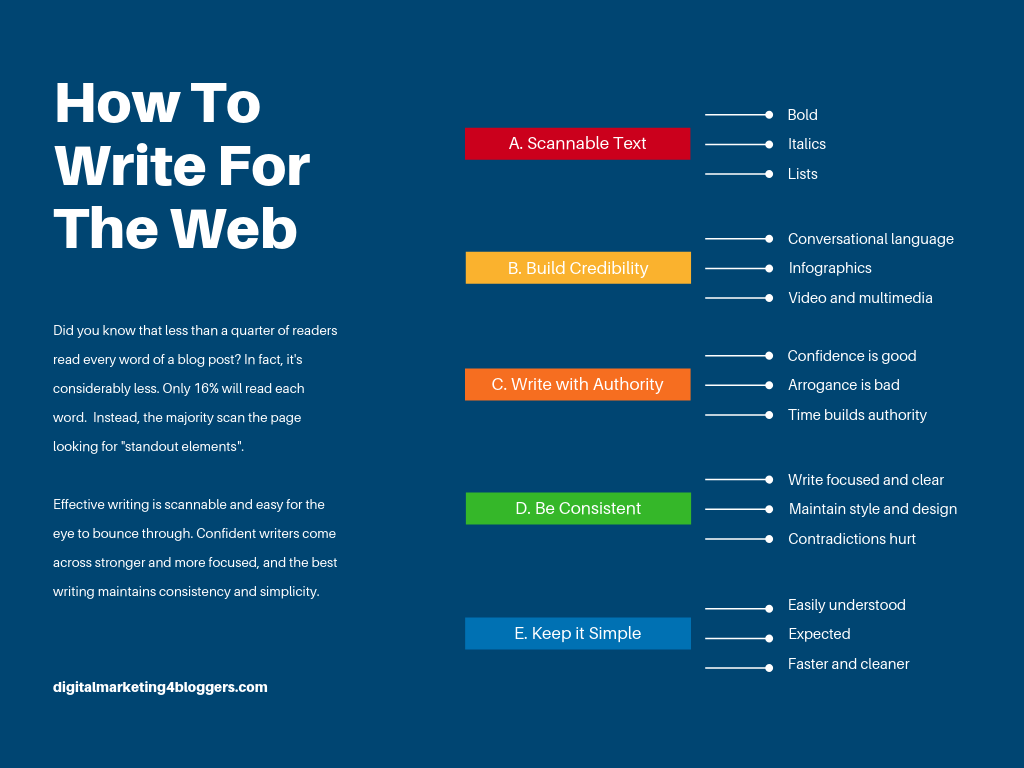Did you know that less than a quarter of readers read every word of a blog post? In fact, it’s considerably less. Only 16% will read each word. Instead, the majority scan the page looking for “standout elements”.
This, according to the influential and insanely detailed Nielsen Norman group, is why good [online] writing includes several key factors that separate it from the rest.
For the record, I used to write like “the rest”. I wrote the way successful authors do. Lots of text. The higher the word count, the better.
Larger paragraphs…few pictures.
Because, if you include a bunch of pictures in a short article, users think that there isn’t a lot of value and will move on. I gotta look like I know what I’m talking about!

The trouble was my stuff didn’t get read, and even when it was read, the comments weren’t always positive. It was a problem, and the problem stemmed from my not understanding how to write effectively for the online medium.
Believe it or not, there’s science behind what works. Content writing isn’t easy. And if you care about digital marketing, writing effective content is even tougher because the standards are higher. And, more is riding on getting it right.
Part of the problem is our attention spans are worse than goldfish.
No, seriously. Thanks to smartphones, writes The Telegraph, our attention spans are scientifically worse than those little gold-colored fishies we keep in fish tanks.
“According to scientists, the age of smartphones has left humans with such a short attention span even a goldfish can hold a thought for longer.”
We can’t write like we were taught in school and expect readers to, you know, stay with us and keep reading until the end.

How to write for the web using simple standout elements in three easy steps
Let’s jump back to the Nielsen Norman study. Their study, along with so many others, help to prove that readers just don’t read. Most only get halfway down the page. Don’t make me think, writes author Steve Krug. Let me scan.
Okay, got it. Readers don’t read. Their attention spans are microscopic and we need to figure out how to connect with people. As quickly as possible.

How do effective bloggers do this? According to the Nielsen Norman study:
Step 1: Web pages have to employ scannable text
Instead of writing paragraph after paragraph of text that all looks the same, conform to your reader’s natural desire to jump around by giving them visual aids.
These aids include:
- highlighted keywords (hypertext links serve as one form of highlighting; typeface variations and color are others)
- meaningful sub-headings (not “clever” ones)
- bulleted lists
- one idea per paragraph (users will skip over any additional ideas if they are not caught by the first few words in the paragraph)
- the inverted pyramid style, starting with the conclusion
- half the word count (or less) than conventional writing
In other words, make each blog post a visual masterpiece. Through the use of bold and italicized text, headings, links and color changes, you’re identifying for the user key areas on which to focus the eye and keep him or her engaged in the content.
My friend Pete from Do You Even Blog does this incredibly well.
What else? Users hate reading copy that sounds like “marketese” – in other words, sales copy. Readers don’t respond when they believe that they are being sold. Or, if the post contains a click-bait title. Or, it was written purely for SEO.
Instead, most readers interpret these qualities to hurt the author’s credibility, and being credible online is a huge undertaking. After all, very few of our readers personally know us. They don’t know our qualifications or whether we actually know what we’re talking about. Most of them only have access to our writing.
And, this brings us to step 2: credibility.
Step 2: Build and maintain credibility using these techniques
Like I said, credibility isn’t easy to build and it’s even tougher to maintain. Through your writing, effective use of certain techniques can help that process.
Techniques to help boost your credibility as a blogger:
- Write using normal conversational language
- Include helpful graphics (like infographics) in the post
- Consider creating videos or screencasts to aid visual learners
- Offer outbound-links to highly credible websites
- Don’t come across arrogant, but confidence is a virtue
What else?
Write with authority. If your writing appears wishy-washy, your audience won’t grab hold of your position and fully consider it. Be strong and confident.
Acknowledge external expertise. Confidence is great, but arrogance isn’t. Link to experts in the field even if they are your competition. Be honest with your readers and connect them with those who are equally as knowledgeable as you.
Encourage feedback. At the end of your article, ask for people’s opinion. If you aren’t afraid of differing opinions, then you’re pretty darn confident in your own.
Be consistent. Content that is an incomprehensible mess of ideas that conflict with each other kills reader confidence in you. Stand by your writing. Write consistently.
Step 3: Simple is almost always better
In 2012, Google published a study that concluded simple websites are almost always more effective than complex ones.
Why?
The “simple is better” philosophy can be broken down into three primary areas.
Simplicity:
- is easily understood
- is expected
- is often faster, cleaner
For most of us, we’re happier people when we figure things out quickly. When things work the way we expect them to work, we complete our tasks faster and without added stress. We expect this. For many of us, we also demand this.
I get it, it’s fun to be creative sometimes. Or clever. It gets us out of our comfort zones a bit and trying new things. I encourage trying new things when those new things do not get in the way of what works, or when it adds unnecessary complication.
How can writers keep their pages simple?
- Use basic font styles (ie: no cursive or wild-looking fonts)
- Use readable and contrasty font colors (black on white is good)
- Do not overbold or over italicize (keep those elements special)
- Write shorter and more concise paragraphs
- Learn to love white space; use white space often
- Don’t overwrite. Writing for word count shows (and not in a good way)
Here’s a cheat sheet (infographic) that’ll help you to keep these techniques in mind:

Are you a successful online writer? Tell me, what techniques do you use to succeed in grabbing (and keeping!) your reader’s interest?





